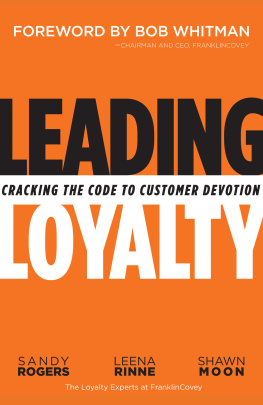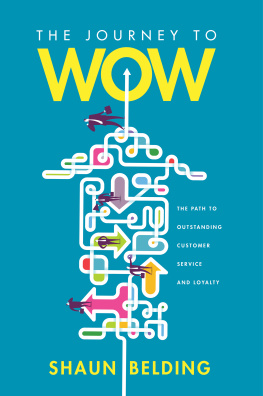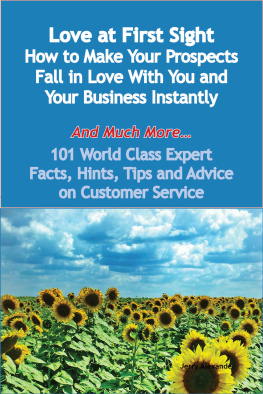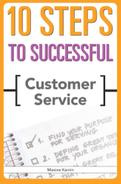Contents
THE LOYALTY LEAP FOR B2B
PORTFOLIO / PENGUIN
THE LOYALTY LEAP FOR B2B
Bryan Pearson is the president and CEO of LoyaltyOne Inc., a global provider of loyalty strategies, programs, and enterprise loyalty solutions and part of the Alliance Data family. As leader of LoyaltyOne and author of The Loyalty Leap, Pearson is a highly sought-after speaker at conferences around the globe and is widely regarded as an expert on enterprise loyalty and coalition marketing. He lives in Toronto.
Visit www.pearson4loyalty.com.
The Loyalty Leap for B2B
Turning Customer Information into Customer Intimacy
Bryan Pearson
A PENGUIN SPECIAL
PORTFOLIO / PENGUIN
Published by the Penguin Group
Penguin Group (USA), 375 Hudson Street,
New York, New York 10014, USA
USA | Canada | UK | Ireland | Australia | New Zealand | India | South Africa | China
Penguin Books Ltd, Registered Offices: 80 Strand, London WC2R 0RL, England
For more information about the Penguin Group visit penguin.com
First published in the United States of America by Portfolio / Penguin, a member of Penguin Group (USA), 2013
Copyright Bryan Pearson, 2013
All rights reserved. No part of this product may be reproduced, scanned, or distributed in any printed or electronic form without permission. Please do not participate in or encourage piracy of copyrighted materials in violation of the authors rights. Purchase only authorized editions.
ISBN 978-0-69813-823-0 (ePub)
While the author has made every effort to provide accurate telephone numbers, Internet addresses, and other contact information at the time of publication, neither the publisher nor the author assumes any responsibility for errors, or for changes that occur after publication. Further, publisher does not have any control over and does not assume any responsibility for author or third-party Web sites or their content.
About the Book
Since the publication of the New York Times bestseller The Loyalty Leap, Bryan Pearsons customer loyalty approach to marketing has changed the way many organizations use their customer data. Small coffee shops and large corporations have applied The Loyalty Leap principles to effectively deliver mutual value to customers. But many readers have asked the same question: How can I apply these lessons in a business-to-business context?
While the principles outlined in The Loyalty Leap hold true whether the customer is an individual or a business, the application of the Loyalty Leap steps can vary. While an individual might respond favorably to one sales pitch, a large corporation with a complicated sales chain might respond very differently.
Drawing on his own experience and extensive research, Pearson helps B2B marketers avoid the pitfalls of loyalty marketing to businesses. He helps marketers segment their market into small business, large enterprise, and channel marketers, and explains how a customer loyalty plan can be adapted for each segment. Sharing case studies of successful B2B loyalty initiatives, he shows that B2B customers working in any segment can successfully take The Loyalty Leap.
The Loyalty Leap for B2B is a practical guide that will help you cultivate loyalty in your business customers.
Introduction
What Is a B2B Loyalty Leap?
In May 2012 my first book, The Loyalty Leap: Turning Customer Information into Customer Intimacy, was published. My goal with the book was simple: to create more enriched customer experiences through the responsible use of data.
Since its publication, The Loyalty Leap has made the bestseller lists of the New York Times, Wall Street Journal, and USA Today. Excerpts have been included in national magazines. Most important, the books message has inspired many organizations and marketing experts to change the way they use their data so that it delivers mutual value to the customer. Ive seen small coffee shops and national grocers apply the principles that I learned over the years. Ive been privileged to talk about making the Loyalty Leap to audiences around the globe, from Asia to Arizona. And during this time, audience members consistently asked the same question: How can I apply these lessons in a business-to-business context?
To do that, we must first review the concept. What exactly is the Loyalty Leap? I define it as using data to build emotional loyalty. Tactically, that means placing the customer above all other organizational missionsproduct, service, profitand then basing every decision the company makes on what is meaningful to that customer, by using the customers information and sharing that data across the enterprise. Organizations that do this, that are customer committed, stand apart from those that try to compete on price or innovation because they connect with the customer on an emotional level, creating meaningful (and profitable) differentiation.
Based on this customer-committed approach, youd think that organizations operating in the B2B (business-to-business) environment would easily be able to make the Loyalty Leap. If the company can place the consumer at the center of its purpose, then it should be able to place its business customer above all other missions as well, right? Seems logical. But the more I listened to my readers and examined business case studies, the more I realized that companies operating within the B2B realm are facing completely different issues than their B2C (business-to-consumer) counterparts. The concepts and principles I outline in The Loyalty Leap certainly do apply, but their application must be adapted to be effective.
Explaining the best way to customize the Loyalty Leap principles for B2B initiatives required me to first ponder a new set of needs that were not addressed in The Loyalty Leap. This book is the result of that pondering and is my attempt to provide an answer to all those questions over the last year.
Chapter 1
Bon Voyage for B2BAre You Prepared to Launch?
In 1999, the same year that Bertrand Piccard and Brian Jones became the first to circle the globe in a hot air balloon, the carrier Air France launched a feat decidedly more down-to-earth: a loyalty program designed specifically for businesses.
The program, called VoyageurREWARDS, did not make world headlines, but it did have the potential to set a business-to-business rewards movement to flight. The program allowed companies to earn points on booked trips that could later be used by company employees for free travel or upgrades. A good start, but the company didnt stop there. The distinguishing feature of the plan was that individual employees who belonged to Air Frances consumer frequent-flyer program, Frquence Plus, could still accrue their own points, separately.
With this program, Air France captured the key loyalty design elements that would resonate with business: it created value for partner companies and their employees, while providing Air France access to vast amounts of proprietary datathe kind that serves as a window into corporate travel preferences, trends, and needs.












